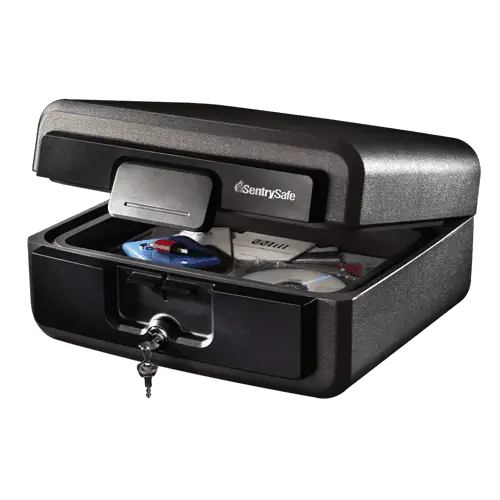When you buy a safe, you first want to protect your valuables from burglars. Then, you realize that this is not the only threat and you usually think of fires. That is why being fireproof is the second most requested feature requested when in the market for a safe. But when you know that floods are the number one natural disaster in the United States, how about considering water damage? How can we have are valuables protected in the case of a sudden flood?
Are safes waterproof and airtight? A fireproof safe is not generally waterproof and the vast majority isn’t. Those safes have at best intumescent seals that expand in the case of a fire: they serve no purpose in the case of a flood. A waterproof safe needs to have a rubber seal that prevents water from leaking in. You can always add lock chest in your fire safe to upgrade it if you already own one.
If your safe is not waterproof, you might think that your documents have long been at risk and you must take action now. If you are in the market for a safe, a waterproof safe is a no brainer; but not all safes are created equal. Some makers use that label lightly and their safes don’t live up to our expectations. Read on.
Evaluating risk
- Flood, hurricane or water leak
There might be a flood, as many people suffered on several occasions. Or there might be a hurricane in your town. There might also be a pipe that bursts in the basement. Many reasons can lead to water damage to documents and valuables. - Fire risk
It is somehow counter-intuitive. Floods not only happen more often than we think but in the case of a fire, a sprinkler system or the fire department with their high power hose can damage your documents pretty quickly. So there is not only a flood risk if you fear water damage. - What insurance has to say
According to insurance companies, water damage is one of the most common claims on home insurance. They deliver further numbers: a house has a 26% chance of being damaged by a flood in a 30-year period. And not only in high-risk flood areas. People outside of these mapped areas still file more than 20% of all claims concerning flood in National insurance program. And floods are the number one natural disaster in America.
How waterproof safes are made and tested?
Usually, a safe is made waterproof by the means of a closed-cell foam gasket. When you close the door, the lid is closed. Then, some pressure is applied to the foam that makes a waterproof and airtight barrier between the water and the safe.
How waterproof safes are tested? Sentry safes, for example, test their safes and chests 72 hours for water intrusion. Safes are simply submerged in water tanks with the interior thoroughly monitored during that time. This gives enough time to come and inspect documents and valuable in the case of an incident.
In addition to that, ETL provides independent testing and verifies water resistance and submersion. They provide their ratings to make sure safes are protected against flooding or any other water damage. Digital media, back-ups, documents, photos will be safe in the event of a catastrophe.
Are fireproof safes waterproof?
The short answer is no. A fire-safe does not protect against water damage whatsoever. I have carefully detailed what fire safes are made of in this lengthy blog post. You can refer to it if you want to fully understand the difference.
In a nutshell, a fire safe is made of two sheets of steel with fire retardant material in-between. The door comes with a seal that serves no purpose: it is not air or watertight unless enough heat makes it expand. It is a very special intumescent seal. And not all fire safes have that seal.
To be watertight, a safe has to have a very special seal, that we referred to earlier as a closed-cell foam gasket (see above). This gives the air-tight ability a safe has to have in order to be watertight. And a waterproof safe doesn’t need to have one or two or even three layers of steel. This has nothing to do with water protection: only “burglar protection”.
So a fire safe is not automatically waterproof. Remember to check the spec sheet before buying one. Sentry safes have fireproof AND waterproof safes.
Should I choose a waterproof safe?
I think the answer is clear: it is a big “yes”. But keep in mind, if you already have a safe, don’t throw it away just yet; there are a couple of options that might save you some money. Read below.
Let’s see in details the pros and cons of a waterproof safe. If you live in an apartment which is not on the first floor (or ground floor), you might not risk a plain flood. The only risk, again, might be water damage in the case of a fire (fire department or sprinkler system). In that case, a good fire safe with an intumescent seal might be enough. If have to buy a new safe, and the fireproof safe you are in the market for don’t have that seal, instead you should choose a fire and waterproof safe.
If you live in a house, you might consider installing your safe on the first floor, the garage or even the basement. In those cases, your valuable are highly at risk in the event of a flood. You should keep that risk in mind and not see your safe as a protection against burglars, but also as a kind of “time capsule”. It has to protect your valuables against theft, fire, and water. You should definitely choose a waterproof safe, you will not regret it.
Keep in mind that a waterproof safe is airtight. It will provide additional help against moisture. You will find easier to fight moisture and mold in your safe with a waterproof safe. Put inside products that absorb moisture when you close your safe. As no air can come through the seal, the air inside will dry out quick leaving your paper and documents mold and stain free.
Things to consider: humidity
I have covered on several instances that humidity can be a problem if you own a safe. It is particularly true if your safe is waterproof. For example, Sentry sells good waterproof safes that are airtight. Consequently, moisture from the air can get trapped inside the safe when you close the door. You will be exposed to the risk of moisture in the long term. It is recommended to open the door once in a while to let fresh air in, but also to keep a desiccant pack inside to capture moisture when the door is locked. The pack has to be replaced or reactivated in the oven at least every six months or earlier if your environment is particularly humid.
This desiccant pack from Amazon is the one I use successfully. It is really cheap considering the help it provides to protect your documents from humidity and mold in the long term. This pack is useful as well in a waterproof box as an option for your safe (see below). But even if your safe is not waterproof, a desiccant is a good idea.
What are my other options?

You have understood why you should opt for a waterproof safe; the only thing is you have already bought and installed a brand new safe you are perfectly happy with. What to do, then? Throw it away and buy a new one? That might not be quite cost-effective. All that money for an unlikely event, a tiny risk?
Well, there is a way to upgrade your existing safe with a fireproof and waterproof chest that makes a perfect sense for many people. You will have your existing regular safe with its shelves. There you can add one or several chests. They come as boxes with a lock and protected storage inside.
A fire-water chest provides usually 30 min fire protection at 1550°F (843°C) and up to 72 hours ETL verified protection against flood damage. For example, a medium chest from Sentry offers an interior capacity of 0.37 cubic feet.
This is the one I recommend from Amazon.
Just measure properly to make sure the chest fits perfectly in your safe, and keep in mind that it has to come through the door. The opening is sometimes less wide than the interior itself.
So you can perfectly upgrade a regular or cheaper safe: how much money did I save you? You can have a look at all the further upgrades I have detailed in this page and explained how you can take advantage of them.
Conclusion
A fire safe is not usually waterproof. You have to ask for one, in you want that functionality, which is recommended. Water damage can happen, whether it be due to a flood or not. In that case, you always want to protect your valuables, documents, photos, back-ups and so on from damage. A waterproof safe is a solution. If you don’t want to spend that money or if you already have a safe, a good option is often to upgrade your safe with a fire/water chest.

